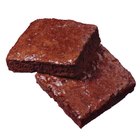
Perhaps even more American than apple pie, the first published recipe for brownies is in the "Boston Cooking-School Cookbook," published in 1906 and edited by Fannie Merritt Farmer. Whether you favor the heirloom recipe that features brown sugar and melted chocolate, a boxed mix or a modern recipe with white sugar and unsweetened cocoa, eggs play a starring role. Most brownie recipes call for at least one or two eggs -- or an equal amount of pasteurized egg substitute. The eggs do more than add flavor. Without them, the entire structure of the brownies changes.
Brownie Bits
Eggs are rich in protein, which provides structure to baked goods. In raw eggs, the protein molecules form tightly coiled strands. As the brownie batter heats, the protein molecules relax and the strands unwind and link together. These protein molecules help brownies change from a semi-liquid state to a solid state. Without eggs, the brownies won't hold together when baked. You'll find yourself with a crumbly mess.
Left High and Dry
Another trick eggs perform is to keep brownies moist. Eggs have emulsifying properties. They coat the other liquids and fats in the brownie batter to prevent moisture loss. Lecithin, specifically, which is found in the egg yolk, helps keep baked goods moist and tender. Eggs can also act as a leavening agent. When they're beaten into the batter, they trap air pockets, which causes the brownies to rise slightly in the oven. Without eggs, the brownies will likely be dry, flat and hard.
A Quick Fix
If the brownies are already in the oven and halfway through the baking time when you realize your mistake, there's not much you can do. The brownies will still be safe to eat, but they won't taste as good. If you remember the eggs, though, before or just after you put the brownies in the oven, you can still salvage them. Scoop the raw brownie batter out of the prepared pan and back into your mixing bowl. Wash and dry the pan and spray it with nonstick cooking spray again. Mix the eggs into the brownie batter and pour the batter into the prepared pan. The brownies may taste slightly more oily than usual because of the extra oil from the pan, but you probably won't notice this difference as much as you would the missing eggs.
Worthy Substitutions
If you're out of eggs or you're just trying to avoid eggs, substitute other common pantry items instead. To add moisture and lift to an egg-free brownie batter, mix in a few tablespoons applesauce or a bit of mashed banana, along with a pinch of baking soda. A spoonful or two of tapioca starch combined with a little warm water can help bind an egg-free brownie batter, according to Brittany Angell, author of "The Gluten-Free Baking Guide."
Related Articles

What Happens if You Use Brownie Mix ...

How to Cook Eggs Sunny Side Up Without ...

I Forgot to Put the Egg in the Banana ...

How Much Applesauce Do You Substitute ...

How to Replace Eggs With Mayonnaise

What if You Forget to Put Eggs Into ...

How to Make Your Deviled Eggs Look Great

Does Adding an Extra Egg to Brownie Mix ...

Chocolate Chip Cookie Dough Brownies

What Can I Use as an Egg Substitute ...

How to Cook Eggs in Cupcake Pans

Using a Convection Oven to Cook ...
How Long Before a Hard Boiled Egg Goes ...

How to Fry Brownies

Shelf Life of Hard Boiled Eggs

How to Make Omelets With Baking Powder
The Chemistry of Baking Brownies

Can I Make Boxed Devil's Food Cake Mix ...

How to Bake Cookies With Bananas ...

The Calories in a Cheese Omelette
References
Writer Bio
Julie Christensen is a food writer, caterer, and mom-chef. She's the creator of MarmaladeMom.org, dedicated to family fun and delicious food, and released a book titled "More Than Pot Roast: Fast, Fresh Slow Cooker Recipes."
Photo Credits
Jupiterimages/Comstock/Getty Images